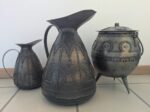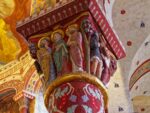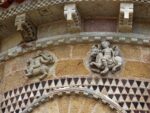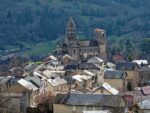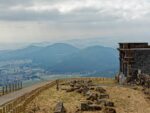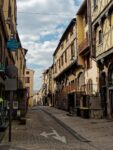There is a comprehensive sets of photographs
Around Clermont-Ferrand
Clicking on a photograph in the text will open the image in a separate window
The printable PDF version is E2E2025no1C.pdf (four A4 pages)
As our neighbours were leaving one January afternoon after Christmas cake and wine with us, Jean-Marie, who collects old cigarette lighters among other things, commented on the two metal jugs and the cauldron by our door. We had found them back in 2003 on different stalls in a flea market in Turkheim, Alsace. We thought they might be holiday souvenirs from a village coach tour in Tunisia or another North African country, an impression reinforced when we saw a similar jug in Huttenheim’s flea market a couple of years later. How wrong can you be! After Jean-Marie’s interest, John looked on the internet and found an identical one on an antiquarian website; it was labelled Arts And Crafts: Cruche à Décors D’alpha Et Oméga 1900. It sold for 130 euros. It clearly pays to go to flea markets – Helen’s diary records that we had paid 5 euros for each of our Art Nouveau treasures.
Curiosity aroused, Helen looked for information on other Alsace flea market purchases. We have always said that they have better quality fleas on the Alsace side of the Vosges mountains than of our side. But it was uncomfortable to read about the stylish small cast iron wall plaque which now hangs in our hall in Letchworth. It depicts a young man and woman leading two cows and reminds us of the cows back in Entre-deux-Eaux. It had caught our eye in Ammerschwihr’s flea market and seemed a bargain at 1.50 euros. The German sculptor of the large cast iron relief, on which the smaller plaque was based, was Hanna Cauer. She had complained in a letter of 1933 to the new National Socialist Minister of Culture that “the reigning Jewish-Marxist circles were absolutely hostile to my German approach to art” and appealed for support “with renewed hopes in our national government”. She was awarded a string of public commissions, including a bust for the Reichstag, two statues for the Nuremberg Opera House, and a fountain for the Olympic celebrations in 1936. In 1937, Adolf Hitler gave her a one-off payment of 5,000 Reichsmark, and she received special subsidies for materials well into the war years. Joseph Goebbels, minister for propaganda, called the Olympia fountain ‘wonderful’. He and Hitler visited Cauer’s studio in December 1937. Goebbels wrote in his diary: “Hanna Cauer has created marvellous female sculptures. She has great talent. I’m giving her a whole series of commissions. The Führer, too, who joined us a little later, is giving her commissions and advances. She is very happy.” And we still like our plaque.
Our “flea” researches provided interesting interludes between various medical appointments, car appointments and meal engagements. We had spent New Year’s Eve at Stevenage Hospital trying to get some strong pain relief for John before the long drive back to Entre-deux-Eaux on 3rd and 4th January with what he assumed to be a kidney stone. It was all very efficient in the Adult Urgent Treatment Centre, given all one hears about Emergency departments, and we did not have a lot of waiting around. The downside was banging the car against an unseen low wall in their multi-storey car park! Our Letchworth neighbour told us afterwards that it was notorious for accidents and thought there must be at least 10 mishaps a day there from people who were not forewarned. Both John and the car have had follow-ups. John’s ultrasound and MRI scans (taken long after the pain and the kidney stone had gone) revealed that he had a stone stuck and partially blocking the bile duct, and, although it is not causing any problems, he had an ERCP done in Colmar on 15 April to remove it. As for the car, it has been at a garage in Saint-Dié for bodywork repairs. We tried looking at new Honda cars, but the Epinal salesman was still at lunch, and the Colmar one was half-hearted, did not yet have a model he could sell, and hasn’t followed up our visit. So we still haven’t bought another car.
Our gastronomic engagements have been more interesting though less essential than our medical ones. We are, however, still uncertain about aspects of French etiquette. When our neighbours invited us for aperitifs at 18.30, we wondered how long we were expected to stay, whether to take a bottle or some other offering and whether to have a meal ready for when we got home. John found a useful website, but Paris customs might not be the same as village ones. Ghislaine, who comes for English conversation, said that she and her husband had just been to aperitifs with friends and, as he is so talkative, they had not left till midnight, so their friends had had to make them some bread and terrine. Perhaps that would not be what our neighbours were expecting. In the end we took a jar of John’s marmalade (they always seem to like that) rather than wine. Daniele had prepared several plates of savoury snacks, so we had no need of a meal afterwards. And we stayed for a couple of hours.
In January the Entre-deux-Eaux municipal council, despite Mayor Duhaut’s complaints about reduced grants due to government budget cuts, found funds to invite the over 65s for their annual lunch with music and dancing, unlike some neighbouring villages. Alas the villagers are ageing. The very annoying man who used to bring his castanets and leap around accompanying the musicians was only able to manage a slow shuffle round the dance floor (mainly with all the most attractive females, to his wife’s annoyance). Their next-door neighbour, the wife of the former schoolmaster, used to love dancing, but now has Alzheimer’s and is in a home; she was brought to the lunch and clearly relished the music, dancing and company. The widow of a former fireman had fortunately not brought her inseparable new companion, an excitable, noisy dog (who Helen has noticed at previous events peeing against the drinks trolley).
Another annual event is the Amnesty Book Sale in Saint-Dié in February. This year we got some more old Michelin travel guides, including one for Auvergne. In September as we drove down to visit Val in the south west, we had been very struck by the grandeur of the scenery we passed through around Clermont-Ferrand with the Puy de Dôme and chain of volcanic Puys. So at the end of March when we had a week without appointments, we left the mountains of the Vosges, whose rounded summits are named “ballons”, and headed for the puys, clutching our Auvergne guidebook. We were prepared to be impressed, as the highest ballon is the Grand Ballon at 1424m. whereas the Puy de Dôme summit is1465m. We were disappointed on arrival that, after a previous week of sunshine, the skies had clouded over, and the top of the Puy de Dôme was shrouded in cloud.
We were staying in an apartment in the centre of Clermont-Ferrand, off Place Jaude, lively with cafés, restaurants and a shopping centre. So on our first cold morning we turned our back on the obscured Puy de Dôme summit and explored the old town with its narrow pedestrian streets, covered market and 12th century basilica. “Mosaic” conjures up images of intricate Roman floors, but in the case of the basilica referred to the striking patterns in black (lava) and cream (arkose) stone round the outside of the apse. Inside, the nave resonated with the ritual prayers of two men in a side chapel, the carved capitals told their stories, and the miracles of the black virgin in the crypt were thanked on marble ex-voto plaques. Outside, after passing an Art Nouveau bakery and small sewing and dry cleaning shops we warmed up over good coffee and the best-ever cinnamon buns in a café near the black lava cathedral. Inside, the cathedral was noisy with drilling and the crypt was closed, but some fresco remains and early twentieth century windows were attractive.
Next day, we were glad of Waze GPS to direct us through all the roadworks and improvements which are being undertaken in Clermont-Ferrand (the tourist office had said Waze was essential with the constantly changing closures). At the end of all the chaos, the town should also be able to display the archaeological finds uncovered during the works.
Inspired by the beauty of the basilica, we made a circuit of Romanesque churches in nearby small towns and villages, starting at Issoire. Its church had a similar striking mosaic stone pattern outside with the unusual addition of sculpted stone signs of the zodiac. Inside it was a riot of colour, as a nineteenth century “restoration” had controversially painted all the walls, columns and capitals, like a rich tapestry. Colour continued in a nearby pretty-pretty pink patisserie with a fastidious pink lady and silent grey daughter.
Fortified by coffee and crumble we drove on small country roads to Saint Saturnin with its Romanesque chapel and church perched on a rocky outcrop and dedicated to the martyred first bishop of Toulouse.
We had heard of Saint-Nectaire, having eaten its cheeses, and we passed plenty of farms advertising their cheese, as we approached the village of Saint-Nectaire in the valley below us. We were ignorant that it was protected not by a saint of cheeses, but by the evangelizer of the Couzes valley, over whose tomb the church had been built. There were scenes of Saint-Nectaire’s life along with scenes of the Passion, Resurrection, Last Judgement and from the Book of Revelations on capitals round the choir – the finest we saw that day. Helen was amused by the wide-jawed crocodile threatening the rescue of the baby Moses from the water on a capital at one side of the nave, while on the other was a donkey with a lyre.
After that playfulness, the volcanic stone and grey flagstones of Orcival‘s church in a pilgrimage resting village seemed cold and unwelcoming despite its reputation. Our route back to Clermont-Ferrand took us close to the Puy de Dôme.
On our last day, the weather was clearer, and we drove to the huge, but almost deserted, car park at the foot of the Puy de Dôme. Once we would have relished trudging up the Chemin des Muletiers to the summit, but now we were glad of the eco-friendly electric rack train (or train à crémaillère – just showing off recently acquired vocabulary!).
From the station near the top, we climbed the steps almost to the summit where there is a transmitter for FM radio and TV, and physics laboratory/observatory dominating the remains of the Roman Temple of Mercury. We walked on, enjoying the panoramas of the surrounding puys, though they were getting hazy and the wind was cold, before visiting the small museum with its information of the construction methods of the Temple, the Via Agrippa, the quarries and also the Roman remains in Clermont-Ferrand.
After our descent, Waze guided us to the Montferrand part of the city (Clermont and Montferrand merged in 1630), which was interesting to walk round, though the bars offering coffee were dispiriting.
We had tried different restaurants each evening in Clermont-Ferrand, and on our last evening the highlight of our dinner at Popina was the Pariou dessert, a delicious nutty cake based on a Creusois cake, but made with different flour and nuts; when it sank in the centre like a volcano, the chef named it after the Puy de Pariou.
Next day we returned from the Puys to the Ballons, as the clocks changed, and we embarked on a round of rendez-vous, medical (rheumatology and visceral) and mechanical (boiler and car) with light relief of lunch at the Imprimerie in between. All being well with body work (human and car), our next trip will be to the UK just after Easter.
As in previous years, a pair of kestrels has been visiting the nest since mid-March so hopefully they will take up residence and raise a family without any of the problems that occurred last year.
Individual sets of photographs:
Clermont-Ferrand, Issoire, Montferrand, Orcival, Puy De Dôme, Saint-Nectaire, Saint Saturnin

